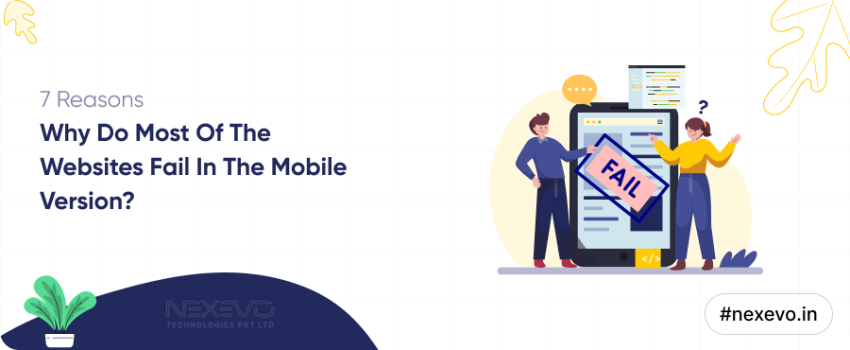7 Reasons Why Do Most Of The Websites Fail In The Mobile Version?

It is impossible to underestimate the importance of having a mobile-friendly website in the current digital era. Since the majority of internet users use mobile devices to access websites, it is now essential for users as well as businesses to provide an error-free mobile experience. Even yet, a lot of websites still have trouble providing the best possible user experience on mobile devices. So, why do so many websites fail on mobile? What is the reason why most of the website works well on desktop but not on mobile?
7 Reasons Why the Websites Fail In The Mobile Version
Let’s explore the most common mistake that makes our website not work in the mobile browser.
1. Unresponsive Design:
One of the primary reasons why our website fails in the mobile version is the lack of responsive design. A responsive website provides a consistent and user-friendly experience across all devices and adjusts its layout and content to fit different screen sizes. When flexible design isn't used, people get frustrated and leave the site because of awkward layouts, small text, and difficult navigation.
For example, a clothes retailer's website may look fantastic on a desktop computer, but it may be too small and difficult to see on a smartphone. Buttons may be hard to press, that text is too small to read, or both. Mobile users will have a terrible experience on a website that isn't responsive since it can't adjust to multiple screen sizes.
Self-test: Let's make the blog more interesting, just grab our phone and visit your website, How does it look? Is the layout responsive to different screen sizes? If not, let's discuss how to make your website responsive design in mobile browser.
2. Slow Loading Times:
Mobile device users expect to have fast loading speeds, therefore any load delays may cause a high bounce rate. Unfortunately, a lot of websites fail to take the necessary steps to take care of mobile-friendly adjustment content adjustments, which results in performance lagging in smaller displays and make your website fails to work in mobile version browser.
Let's discuss how to test the page loading time
One can make use of Google PageSpeed Insight which is a free tool provided by Google. You can analyze our website
performance on both mobile and desktop versions.
3. Complex Navigation:
Every website must have efficient navigation, but on mobile devices with small display screens having proper and efficient navigation is more important. When a website doesn't have adequate navigation the mobile visitors get overloaded with complicated menus and layers, which makes it difficult to get needed information fast. Improving the mobile user experience requires simplifying navigation by adding search tools, breadcrumbs, and clear menus. The complexly made navigation may result in the website not working in mobile browser.
Imagine you are trying to book a flight on a travel website using a mobile device and finding yourself in the maze to
find the menu and submenu is annoying, isn’t it?? Finding the right flight becomes a difficult task as you struggle
between improper navigation menus.
Having a navigation that provides clear categories and a user-friendly search function would greatly improve the mobile experience.
4. Small Tap Targets:
The mobile users interact with the mobile through touch gestures such as tapping and swiping. However, some websites have poorly designed tiny tab targets, which makes it difficult for the user to click the accurate tab, especially on small screens which also the reason why your website fails to work in mobile browser. It is easier to use and less frustrating for mobile users to enlarge buttons, links, and form fields.
Check your phone and click the elements on your website. Are they easy to tab or do they require precision?
Imagine you are trying on a tiny “buy now” button on an e-commerce website with your phone touchscreen. Instead of
clicking on buy now ends up with clicking nearby links and buttons due to small size and proximity.
Enlarging tap targets and ensuring adequate spacing between interactive elements would make the website more accessible and user-friendly.
5. Ignoring Mobile SEO:
Search Engine Optimization(SEO) is not limited to desktop websites, equal SEO is important for mobile device versions too. Most of the websites lose out the organic traffic search because of ignoring SEO practices.
Ignoring mobile SEO not only affects visibility in search engine results but also affects the overall user experience. So, remember to focus on SEO to take top in SERP in both mobile device and desktop
Suppose you're searching for a nearby restaurant on your phone, but the top results are irrelevant or outdated listings that haven't been optimized for mobile search. As a result, you're left frustrated and uncertain about which restaurants are truly nearby and open for business.
Implementing mobile-friendly SEO tactics, such as optimizing for local keywords and maintaining accurate business information, would improve the website's visibility and relevance in mobile search results.
Self-test: Evaluate the mobile SEO performance of your website with tools such as Google's Mobile-Friendly
Test. How can visibility improve and organic traffic bring people in? Let's plan together!
6. Inadequate Content Formatting:
Content is king, but to keep consumers interested, it needs to be displayed properly on mobile devices. Text that is too small to read or images that are uncomfortably cropped are the results of websites that do not properly format their information for smaller displays. Readability and user engagement are improved by using a mobile-first content strategy, which includes shorter headlines, concise paragraphs, and mobile-optimized multimedia features.
Eg: Imagine yourself reading a blog post on your smartphone that is lengthy and without headings or bullet points to
break up the boredom. It gets annoying to scroll through walls of text on a little screen, and you end up
quitting the article halfway through. On mobile devices, information can be formatted to improve reading and
engagement by using shorter paragraphs, subheadings, and visual features like photos or videos.
Self-test: Find a page on your website that has badly formatted text. What changes can we make to make it more
readable and engaging on mobile devices?
7. Neglecting Device Compatibility:
A variety of devices with varying screen sizes, resolutions, and operating systems are included in the mobile landscape. Websites that only concentrate on optimizing for a particular platform or device run the risk of losing visitors from other devices. To ensure that all mobile users have a consistent experience, cross-device compatibility must be thoroughly tested on a variety of devices and browsers.
Imagine you are trying to utilize a web application on your tablet and finding out that some aspects don't work or
are damaged since the program was made just for smartphones. You're dissatisfied and upset since you can't fully
utilize the app's capabilities even with a larger screen. Such usability problems might be avoided and a smooth user
experience could be offered to all users by ensuring cross-device compatibility through thorough testing on a
variety of devices and screen sizes.
Try your website with various browsers and devices. Do you have any problems with compatibility? If yes, together, we can debug










